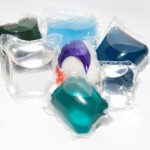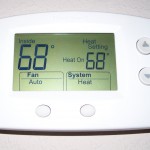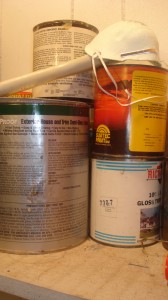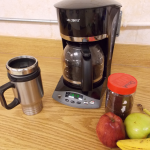by Dorothy C. Lee | Apr 14, 2014

Photo credit: Dorothy C. Lee
Spring is officially upon us. There are few rites of Spring more familiar than the annual Spring Cleaning. It is easier and healthier to live in a clean, well-organized home. Spring Cleaning doesn’t have to be synonymous with drudgery, though.
The key to cleaning is being organized and familiar with the uses of different cleaning products. Today’s cleaning methods and equipment make it more efficient and economical to clean. Be an informed consumer when selecting household cleaning supplies. Selecting a few all-purpose cleaners is more economical and requires less storage space.
Make it easy: Get organized. Gather cleaning supplies. Select a few all-purpose cleaners. Put all of your cleaning supplies, brushes, gloves, rags, etc. into one basket and take it with you as you move from room to room.
Clean with ease. Here are some tips that can help you:
- Clean as you go. For example, make your bed as you get out of it.
- Perform preventive measures to avoid big cleaning jobs later. For example, change filters in heating and cooling equipment regularly.
- Plan ahead. Make a list and check off items as you complete the chore. Establish a flexible cleaning schedule.
- Make sure to follow manufacturers’ directions for use and care of items.
- Incentivize by establishing a goal and rewarding yourself when you’ve accomplished it.
- Get in a cleaning mindset. Put on an exercise DVD and think of cleaning as a workout instead of a chore, or put on music you like to move to and let it energize you.
Consider making your own household cleaning supplies…Granny did! Try baking soda, vinegar, and ammonia for cleaning. These old-fashioned cleaners still work today. Making your own cleaners can cost less and be environmentally safe.
Safety considerations should always be followed when making household cleaning supplies. Never mix chlorine bleach with any other cleaning agents, especially ammonia or vinegar. The combination can create toxic fumes. Do not store cleaning supplies in containers that once held food or beverages – this can lead to mistaken identity and accidental poisoning. Clearly label each container. Store all cleaning supplies out of reach of children. Mix cleaning solutions in a well-ventilated area and clean up after using toxic substances. Store containers tightly closed.
Many household cleaners can be made from inexpensive household ingredients. Following are a few DIY cleaning solutions you can prepare yourself:
Multi-purpose Cleaner
1/2 cup ammonia
1 cup baking soda
2 cups warm water
Mix ingredients in a one-gallon container until baking soda is dissolved, and then add enough water to fill the gallon container. Use ½ cup of mixture in a bucket of water to clean floors, walls, woodwork.
Window Cleaner
Mix together 2 tablespoons vinegar and 1 quart water in a spray container. Spray windows and use crumpled newspaper, if desired, to shine windows.
Mildew Cleaner
3/4 cup chlorine bleach
1 gallon water
Mix and put into spray container. Apply to mildewed area; let stand for five minutes; rinse with water.
Disinfecting Solution
3/4 cup chlorine bleach
1 tablespoon liquid soap
1 gallon water
Mix ingredients together. Wipe surface and let stand for two minutes. Rinse and wipe dry or air dry.
Aluminum Cleaner
1 tablespoon vinegar to 1 quart water or
2 teaspoons cream of tartar to 1 quart water
Add solution to pan and bring to a boil. Boil until discoloration disappears. Empty solution, let pan cool, and rinse.
Consider making your own cleaners before you buy. They cost less and are eco-friendly. Be an informed consumer and spring into cleaning!
For further information, visit the University of Florida/IFAS Solutions for Your Life website.
References:
EDIS publication FCS 3149 Hazardous Household Substances: Alternatives That are Relatively Free of Toxic Effects
“Eco-Friendly Alternatives to Commercial Cleaners and Other Household Products,” Environmental Media Services, www.ems.org
“Safe Substitutes at Home: Non-Toxic Household Products,” EnviroSense, www.epa.gov
by Judy Corbus | Apr 14, 2014
Normal
0
false
false
false
EN-US
X-NONE
X-NONE
/* Style Definitions */
table.MsoNormalTable
{mso-style-name:”Table Normal”;
mso-tstyle-rowband-size:0;
mso-tstyle-colband-size:0;
mso-style-noshow:yes;
mso-style-priority:99;
mso-style-parent:””;
mso-padding-alt:0in 5.4pt 0in 5.4pt;
mso-para-margin-top:0in;
mso-para-margin-right:0in;
mso-para-margin-bottom:8.0pt;
mso-para-margin-left:0in;
line-height:107%;
mso-pagination:widow-orphan;
font-size:11.0pt;
font-family:”Calibri”,”sans-serif”;
mso-ascii-font-family:Calibri;
mso-ascii-theme-font:minor-latin;
mso-hansi-font-family:Calibri;
mso-hansi-theme-font:minor-latin;}

Photo credit: American Cleaning Institute
Are you familiar with the new single-load liquid laundry packets? They are a convenient new laundry product which contains highly concentrated detergent in single pouches. However, if not stored properly, the packets can pose a danger to curious young children leading to injury from ingestion or exposure to the eyes. The American Cleaning Institute urges parents and caregivers to keep these products in a secure location out of reach and sight of young children.
For best results with the laundry packets, follow these tips:
- Like all other cleaning products, keep single-load liquid laundry packets out of the reach of children and pets between every load to prevent unintended exposure.
- For best results, add the single-load liquid laundry packets to the bottom – also known as the drum – of the washing machine, both for top-loader and high-efficiency front-loader machines, before adding clothes. Do not put this product in your machine’s dispenser drawer.
- Do not cut or tear the single-load liquid laundry packets. They are designed to dissolve completely in the machine, even in cold water.
- Read the product label to determine how much product you should use.
- Do not use the single-load liquid laundry packets for washing laundry by hand or to pretreat fabric.
- If the single-load liquid laundry packets stick together, throw them away. The packets can rupture if you try to separate them.
- Handle this product with dry hands only, and remember to close the product container completely after each use to keep out moisture. The film that encases the laundry detergent is designed to dissolve quickly, even in small amounts of water. Store this product away from water.
- Always ensure the re-closable bag or container is tightly sealed after use and during storage.
- As with other laundry products, keep product in its original container with intact labels.
- Store products away from food, as you would with other laundry products.
Take the KEY Pledge (one grand prize winner will receive one electronic gift card in the amount of $2,500.)
- Keep single-load liquid laundry packets out of the reach of children.
- Educate your family and friends about the safe use and storage of these new laundry products.
- You serve a key role in laundry safety.
For more information, watch this short animated video available in both English and Spanish.
Source: American Cleaning Institute
by Judy Corbus | Jan 27, 2014

Set your thermostat to 68 degrees or lower in the winter to reduce heating costs.
Winter definitely is here! Thankfully, we are not shoveling snow here in the Panhandle like our neighbors to the north, but our electric bills most likely have risen as the mercury has dropped. To save money on your winter heating bill, follow these tips:
- Set thermostats no higher than 68ºF when people are home.
- Lower the thermostat when you sleep or are away from home. The Energy.gov website states that if the setback period is 8 hours or longer, savings of as much as 1% for every degree setback can be achieved.
- Put on a sweater or warmer clothing for comfort and lower the thermostat even more. Layer clothing. Closed or tighter cuffs and collars help to retain body heat. An extra blanket or throw will keep you toasty with a lower thermostat setting.
- Use ceiling fans to circulate heated air. Most fans have a switch that allows users to adjust the direction of the fan blade movement. Set fans to move in a CLOCKWISE direction in winter. The upward air flow will move stagnant hot air off the ceiling area and down into the living space. This allows for a lower temperature setting on your heating unit without a reduction in the comfort level.
- To ensure the heat gets to where it is supposed to go, use mastic or foil-faced tape to seal the seams and any cracks in air handling ducts.
- Have the heating system serviced each year to ensure efficient operation.
- Check caulking and weather stripping around doors and windows. Replace as needed to reduce heat loss.
- Clean or replace heating system filters. Dirty filters reduce the efficiency of the heating system and waste valuable fuel. Check filters monthly and clean or replace as directed by the manufacturer.
- Do not place furniture and curtains over or around the heat registers or in front of cold air returns. These items will block the airflow.
- Never use the stove for additional heat. It is dangerous. Besides causing a fire hazard, fumes given off by combustion from gas appliances can result in increased carbon monoxide levels.
- On sunny days, open blinds, shades, and curtains, especially if your windows face south. At sunset, close the blinds, shades, and curtains to help keep heat in your home. This really makes a difference.
For more household energy saving tips, visit the UF/IFAS Energy Efficient Homes series.
Source: No to Low Cost Actions to Save Home Energy and Money
by Elizabeth | Sep 30, 2013
So now the weather is cooling off and you’ve been thinking about doing something to give your home a much-needed facelift. Perhaps now you’re thinking you want to add some seasonal touches. The easiest way to spruce up a home is with a coat of paint. Painting will give the home an updated, refreshed look and the home will immediately seem more defined and welcoming.

Spruce up your house with a fresh coat of paint.
The best time to paint the interior of a home is in the fall or spring. The cooler weather makes working both inside and out much more pleasant. Cooler weather also allows you to ventilate the rooms by opening up windows. When it comes to the job itself with so many paint choices, which one should you choose? Lead-based paints seem to have been eliminated from the US market, however, there are still other issues with paint that need addressing.
According to the Green Builders Coalition, all paint comes in three parts: pigment that gives it color; the binder, or resin, that makes the pigment stick when the paint is applied and forms a solid layer of paint; and the carrier, or solvent, that keeps the paint in liquid form and evaporates once the paint is exposed to air. All of these contain different chemicals. Other substances or chemicals may be added to paint to give it special characteristics, such as mold resistance or moisture resistance.
One additive besides lead that has received much attention recently is volatile organic compounds, or VOCs. Why are VOCs in paint in the first place? They are the “glue” that keeps the pigment and the binder or resin in a liquid solution long enough for the paint to be applied, then they conveniently evaporate so the paint can dry. Therefore, VOCs do serve a necessary function in paint.
Why is there a major concern over high-VOC paints? Like anything that produces high vapors, paints that have high-VOCs may cause or trigger respiratory problems. Consumers need to be aware that, although evaporation is greatest during and right after application, it may continue at lower levels for months. The emitted gases mix with the air in the room, exposing occupants to chemicals that can cause short- and long-term respiratory problems.
The solution is not to leave the house unpainted, but to find low- or no-VOC paints, which are now sold side-by-side with conventional high-VOC paints. Most home improvement stores carry these; consumers just have to do their homework. While there are no building code limitations on use of low-VOC paints, it is imperative that consumers find out more about the product before they select it. The EPA website, http://www.epa.gov/iaq/voc.html#Health_Effects, offers more information on VOCs in general. The National Association of Home Builders also has posted a guide consumers can use to select low-VOC paint on their website: http://www.toolbase.org/Technology-Inventory/Interior-Partitions-Ceilings/low-voc-paints.
Sprucing up your home can be very exciting and painting your home is a great way to express your individuality and ensure your home reflects your sense of style and personality. For more information on maintaining your home, visit the University of Florida/IFAS Extension publications website at http://edis.ifas.ufl.edu/topic_homes.
by Judy Corbus | Jun 7, 2013
Normal
0
false
false
false
EN-US
X-NONE
X-NONE
/* Style Definitions */
table.MsoNormalTable
{mso-style-name:”Table Normal”;
mso-tstyle-rowband-size:0;
mso-tstyle-colband-size:0;
mso-style-noshow:yes;
mso-style-priority:99;
mso-style-parent:””;
mso-padding-alt:0in 5.4pt 0in 5.4pt;
mso-para-margin-top:0in;
mso-para-margin-right:0in;
mso-para-margin-bottom:8.0pt;
mso-para-margin-left:0in;
line-height:107%;
mso-pagination:widow-orphan;
font-size:11.0pt;
font-family:”Calibri”,”sans-serif”;
mso-ascii-font-family:Calibri;
mso-ascii-theme-font:minor-latin;
mso-hansi-font-family:Calibri;
mso-hansi-theme-font:minor-latin;}

Mortgage insurance is required if the down payment is less than 20 percent of the home’s sale price.
If you are shopping for a mortgage, be aware of changes to the Federal Housing Administration’s (FHA) mortgage insurance program. Most lenders typically charge a mortgage insurance premium (MIP) if the borrower puts down less than 20 percent of the appraised value or sale price on a home. Mortgage insurance protects the lender should the borrower default on the payments; the mortgage insurance pays off the loan. Mortgage insurance may be underwritten by private corporations or the federal government through FHA.
Once the borrower has paid down 20 percent of the loan (a loan-to-value ratio of 80 percent), they may discontinue paying the MIP. Federal law requires lenders to tell the buyer at closing how many years and months it will take for them to reach that 80 percent level and cancel the mortgage insurance. Lenders must automatically cancel mortgage insurance when the balance hits 78 percent. Until recently, the mortgage insurance on FHA loans could be dropped at the 78 percent loan-to-value ratio or after five years, whichever was longer.
Effective on FHA case numbers assigned on or after June 3, 2013, mortgages financed with less than a 10 percent down payment will be assessed the MIP until the end of the mortgage term or for the first 30 years of the term, whichever occurs first. In other words, most borrowers will pay mortgage insurance premiums for the life of the loan; they will not be able to drop the MIP at 78 percent loan-to-value. This will add to the overall cost of the loan.
If you are planning to purchase a home, do your homework. Check out the various mortgage options available through different lenders and shop around for the best interest rate. Remember, the larger your down payment, the smaller your mortgage and monthly payment. If you can put 20 percent or more down, mortgage insurance will not be required.
For more information, please contact your local UF/IFAS Extension Office.
Sources: http://portal.hud.gov/hudportal/HUD?src=/program_offices/housing/fhahistory
http://portal.hud.gov/hudportal/documents/huddoc?id=13-04ml.pdf
http://www.bankrate.com/finance/mortgages/the-basics-of-private-mortgage-insurance-pmi.aspx
by Kristin Jackson | Apr 3, 2013

Could this be one of the germiest places in your home?
In 2011, NSF International, an independent, not-for-profit organization, conducted a study with 22 families and analyzed 30 items in their homes. One item that disappointingly made NSF International’s list of the “Top Ten Germiest Places in the Home” was the coffee reservoir. This could be sad news for the approximately 239 million individuals, or 83 percent of American adults, who drank coffee in the US in 2012 (National Coffee Association).
Perk up, coffee drinkers. The good news is the solution is easy: simply clean your coffee maker according to the manufacturer’s instructions and then sanitize. Cleaning will wash/wipe away many bacteria, but sanitizing, according to the National Restaurant Association, is the process of reducing the number of microorganisms that are on a properly cleaned surface to a safe level.
You can sanitize your coffee maker using vinegar. Vinegar can be an effective sanitizing agent for your coffee maker if:
- you use white distilled vinegar (at least 5% acidity).
- the vinegar remains undiluted.
- you heat the vinegar to 130 degrees Fahrenheit or 55 degrees Celsius.
- you leave the heated vinegar on the surface for at least one minute.
 Once the vinegar has remained in the coffee reservoir for at least one minute, you can run the vinegar through the coffee maker. In order to remove the vinegar odor and taste, you may want to follow with a few cycles of clean water. Remember, the water must be clean and you should air dry the reservoir or use a clean paper towel to dry.
Once the vinegar has remained in the coffee reservoir for at least one minute, you can run the vinegar through the coffee maker. In order to remove the vinegar odor and taste, you may want to follow with a few cycles of clean water. Remember, the water must be clean and you should air dry the reservoir or use a clean paper towel to dry.
Now that you know how simple the process is, you are probably wondering how frequently you should take on the task. According to the National Restaurant Association, you should you sanitize:
- after each use
- anytime as necessary
- after 4 hours in use
So now you see how simple it is to keep the coffee maker from being one of the germiest places in your home. To find out other ways to clean and sanitize your kitchen, visit http://edis.ifas.ufl.edu/pdffiles/FY/FY128000.pdf and read Cleaning and Sanitizing the Kitchen: Using Inexpensive Household Food-safe Products. If you have any additional questions or concerns, you can contact your local Family and Consumer Sciences Agent (http://solutionsforyourlife.ufl.edu/map/ ).
References:
NSF International (2004). Top Ten Germiest Places in the Home. Retrieved 26 March 2013 from http://www.nsf.org/consumer/newsroom/fact_top10_germiest_places.asp
ServSafe Essentials 6th Edition. 2011. ISBN-13: 978-0133075687
Janet Buffer, Lydia Medeiros, Mary Schroeder, Patricia Kendall, Jeff LeJeune, and John Sofos; adapted by Amy Simonne for use in Florida with permission. FCS8 OH 2010. Cleaning and Sanitizing the Kitchen: Using Inexpensive Household Food-safe Products. Retrieved 26 March 2013 from http://edis.ifas.ufl.edu/pdffiles/FY/FY128000.pdf
Yang, H., Kendall, P., Medeiros, L., Sofos, J. (2009) Inactivation of Listeria monocytogenes, Escherichia coli O157:H7, and Salmonella Typhimurium with compounds available in households. J. Food Prot. 72(6); 1201-1208







